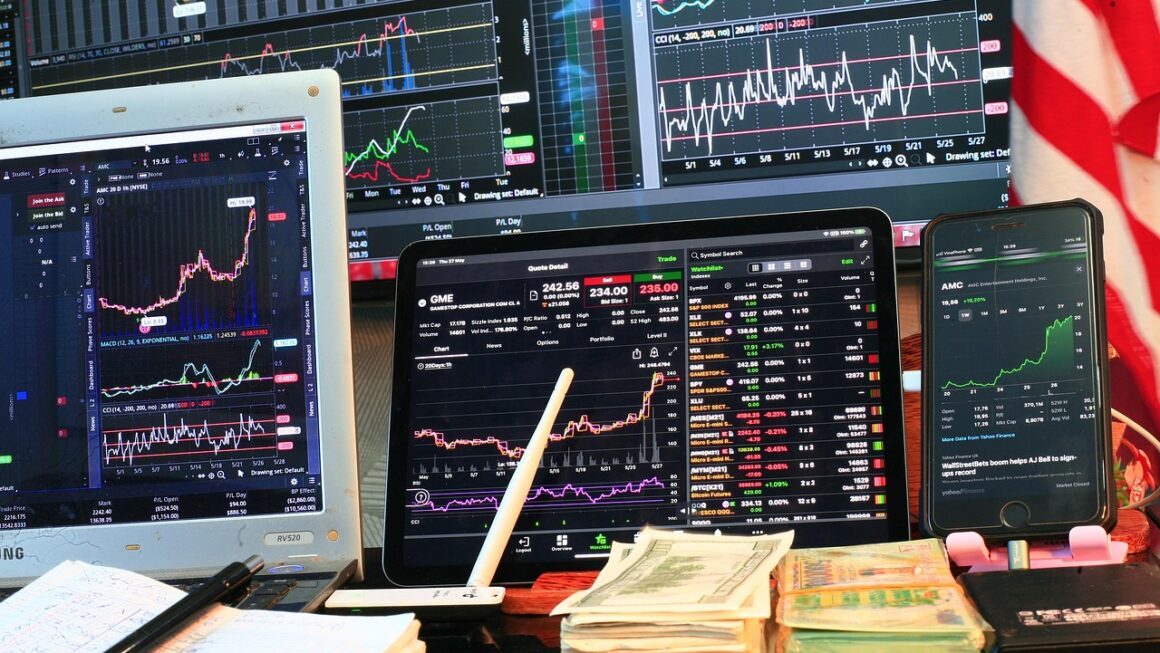Day trading. The very words conjure images of fast-paced markets, blinking screens, and the potential for both rapid gains and devastating losses. It’s a high-stakes game that attracts individuals seeking financial independence and the thrill of the market, but it’s crucial to understand that success in day trading requires significant knowledge, discipline, and risk management. This article dives deep into the world of day trading, exploring its intricacies, potential benefits, and inherent risks.
What is Day Trading?
Definition and Core Principles
Day trading involves buying and selling financial instruments within the same trading day, with the goal of profiting from small price movements. Day traders typically close all their positions before the market closes to avoid overnight risks. This strategy relies heavily on technical analysis, charting patterns, and understanding market sentiment. Unlike long-term investing, which focuses on holding assets for extended periods, day trading is about capturing short-term opportunities.
- Key Principles:
Short-term Focus: Capitalizing on intraday price fluctuations.
Technical Analysis: Using charts and indicators to make decisions.
High Leverage: Often employing leverage to amplify potential gains (and losses).
Discipline: Adhering strictly to pre-defined trading plans and risk management rules.
Instruments Traded
Day traders can trade a wide range of financial instruments, including:
- Stocks: Shares of publicly traded companies. Example: Trading Apple (AAPL) based on intraday news and technical patterns.
- Forex (Foreign Exchange): Currency pairs. Example: Trading EUR/USD based on economic news releases from Europe and the US.
- Futures: Contracts to buy or sell an asset at a future date. Example: Trading crude oil futures based on supply and demand reports.
- Options: Contracts that give the right, but not the obligation, to buy or sell an asset at a specific price. Example: Buying call options on a stock expected to rise significantly during the day.
- Cryptocurrencies: Digital or virtual currencies. Example: Trading Bitcoin (BTC) based on market sentiment and technical indicators.
Key Differences from Other Trading Styles
Day trading contrasts sharply with other trading styles like swing trading (holding positions for a few days or weeks) and long-term investing (holding positions for months or years). While swing traders aim to capture larger price swings over a longer timeframe, and long-term investors focus on fundamental analysis and company growth, day traders are hyper-focused on intraday price action.
- Day Trading: Intraday, high frequency, technical analysis-driven.
- Swing Trading: Few days to weeks, technical and fundamental analysis, moderate frequency.
- Long-Term Investing: Months to years, fundamental analysis, low frequency.
Skills and Knowledge Required
Technical Analysis
A deep understanding of technical analysis is crucial for day trading. This involves studying price charts, identifying patterns, and using technical indicators to predict future price movements.
- Chart Patterns: Head and Shoulders, Double Top/Bottom, Triangles, Flags, and Pennants. Knowing how to identify and interpret these patterns can provide valuable trading signals.
- Technical Indicators: Moving Averages (MA), Relative Strength Index (RSI), Moving Average Convergence Divergence (MACD), Fibonacci Retracements. Using these indicators to confirm trends and identify potential entry and exit points is essential.
- Volume Analysis: Understanding the relationship between price and volume can help confirm the strength of a trend or identify potential reversals. For instance, a price increase accompanied by high volume suggests strong buying pressure.
Fundamental Analysis (To a Lesser Extent)
While less critical than technical analysis, understanding basic fundamental concepts can provide context for intraday movements. For example, a positive earnings report released before the market opens could create a bullish bias for that stock during the day.
- Economic Calendar: Tracking important economic announcements like GDP, inflation data, and interest rate decisions.
- Company News: Monitoring earnings reports, analyst upgrades/downgrades, and other company-specific news that could impact stock prices.
Risk Management
Perhaps the most critical skill for any day trader is effective risk management. Without it, even a skilled trader can quickly deplete their capital.
- Stop-Loss Orders: Setting stop-loss orders to automatically exit a trade when the price moves against you. For example, if you buy a stock at $50, you might set a stop-loss order at $49.50 to limit your potential loss.
- Position Sizing: Determining the appropriate size of each trade based on your risk tolerance and account balance. A common rule is to risk no more than 1-2% of your total capital on any single trade.
- Risk-Reward Ratio: Aiming for trades with a favorable risk-reward ratio (e.g., risking $1 to potentially gain $2 or $3).
Benefits and Risks of Day Trading
Potential Advantages
Day trading offers several potential benefits, including:
- High Profit Potential: The ability to generate significant profits in a short period, especially with leverage.
- Flexibility: The freedom to trade from anywhere with an internet connection.
- No Overnight Risk: Eliminating the risk of adverse events occurring while the market is closed.
- Learning Opportunity: Gaining valuable experience and knowledge about financial markets.
Significant Risks
However, day trading also carries substantial risks:
- High Risk of Loss: Most day traders lose money due to lack of skill, discipline, and risk management.
- Leverage Amplification: Leverage can magnify both profits and losses.
- Emotional Toll: The fast-paced nature of day trading can be stressful and emotionally draining.
- Time Commitment: Requires significant time and dedication to research, monitor markets, and execute trades.
- Transaction Costs: Frequent trading can lead to high commission and fee expenses.
According to a study by the North American Securities Administrators Association (NASAA), approximately 70% of day traders lose their initial investment within a few months. This statistic highlights the importance of proper education and risk management.
Getting Started with Day Trading
Education and Training
Before risking any real money, it’s crucial to invest in education and training.
- Online Courses: Numerous online courses offer comprehensive training in technical analysis, risk management, and trading strategies.
- Books and Articles: Reading books and articles by experienced traders can provide valuable insights and knowledge.
- Mentorship: Seeking guidance from a successful day trader can accelerate your learning curve.
Choosing a Broker
Selecting a reputable and reliable broker is essential.
- Commission Rates: Compare commission rates and fees across different brokers. Look for brokers offering competitive pricing.
- Trading Platform: Choose a platform with advanced charting tools, real-time data, and order execution capabilities.
- Customer Support: Ensure the broker offers responsive and helpful customer support.
- Regulation: Select a broker that is regulated by a reputable financial authority (e.g., SEC in the US, FCA in the UK).
Practice with a Demo Account
Before trading with real money, practice with a demo account.
- Simulated Trading: Demo accounts allow you to trade with virtual money in a real-time market environment.
- Strategy Testing: Use demo accounts to test different trading strategies and refine your approach.
- Emotional Control: Practice managing your emotions and sticking to your trading plan in a simulated environment.
Developing a Trading Strategy
Identifying Market Opportunities
A successful day trading strategy involves identifying market opportunities based on technical analysis, news events, or other factors.
- Trend Following: Identifying and trading in the direction of the prevailing trend.
- Breakout Trading: Identifying stocks that are breaking out of a consolidation pattern.
- Reversal Trading: Identifying stocks that are reversing from a downtrend or uptrend.
- News-Based Trading: Capitalizing on price movements triggered by news releases or other events.
Setting Entry and Exit Points
Precise entry and exit points are critical for maximizing profits and minimizing losses.
- Entry Criteria: Define specific criteria for entering a trade (e.g., a specific chart pattern or technical indicator signal).
- Profit Targets: Set realistic profit targets based on technical analysis and market conditions.
- Stop-Loss Levels: Set stop-loss levels to limit potential losses if the trade moves against you.
Example Strategy: Moving Average Crossover
A simple example strategy involves using moving average crossovers to identify potential buy and sell signals.
- Setup: Use a short-term moving average (e.g., 10-day) and a long-term moving average (e.g., 50-day).
- Buy Signal: When the short-term moving average crosses above the long-term moving average.
- Sell Signal: When the short-term moving average crosses below the long-term moving average.
- Risk Management: Place a stop-loss order below the recent swing low to limit potential losses.
Conclusion
Day trading offers the potential for significant financial rewards, but it’s a challenging and risky endeavor. Success requires a deep understanding of technical analysis, disciplined risk management, and a well-defined trading strategy. Before risking any real money, invest in education, practice with a demo account, and carefully assess your risk tolerance. Remember, most day traders lose money, so approach the market with caution and a commitment to continuous learning. By understanding the complexities and implementing robust risk management strategies, you can increase your chances of success in the dynamic world of day trading.




